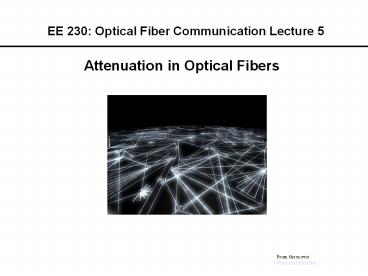EE 230: Optical Fiber Communication Lecture 5 - PowerPoint PPT Presentation
1 / 22
Title:
EE 230: Optical Fiber Communication Lecture 5
Description:
... cm-1; would need six quanta (five overtones) to interfere with optical fiber wavelengths. OH bonds very anharmonic, and strong ... – PowerPoint PPT presentation
Number of Views:389
Avg rating:3.0/5.0
Title: EE 230: Optical Fiber Communication Lecture 5
1
EE 230 Optical Fiber Communication Lecture 5
Attenuation in Optical Fibers
From the movie Warriors of the Net
2
Attenuation/Loss In Optical Fibers
Mechanisms Bending loss Absorption Scattering
loss dBm refers to a ratio with respect to a
signal of 1 mW
3
Bending Loss
Example bending loss 1 turn at 32 mm diameter
causes 0.5 db loss Index profile can be adjusted
to reduce loss but this degrades the fibers other
characteristics Rule of thumb on minimum bending
radius Radiusgt100x Cladding diameter for short
times 13mm for 125mm cladding Radiusgt150x
Cladding diameter for long times 19mm This loss
is mode dependent Can be used in attenuators,
mode filters fiber identifier, fiber tap, fusion
splicing Microbending loss Property of fiber,
under control of fabricator, now very small,
usually included in the total attenuation numbers
Fiber Optics Communication Technology-Mynbaev
Scheiner
4
Bending Loss in Single Mode Fiber
Bending loss for lowest order modes
Mode Field distributions in straight and bent
fibers
Microbending Loss Sensitivity vs wavelength
5
Bending Loss
- Outside portion of evanescent field has longer
path length, must go faster to keep up - Beyond a critical value of r, this portion of the
field would have to propagate faster than the
speed of light to stay with the rest of the pulse - Instead, it radiates out into the cladding and is
lost - Higher-order modes affected more than lower-order
modes bent fiber guides fewer modes
6
Graded-index Fiber
- For r between 0 and a. If a8, the formula is
that for a step-index fiber - Number of modes is
7
Mode number reduction caused by bending
8
Absorption
- In the telecom region of the spectrum, caused
primarily by excitation of chemical bond
vibrations - Overtone and combination bands predominate near
1550 nm - Low-energy tail of electronic absorptions
dominate in visible region - Electronic absorptions by color centers cause
loss for some metal impurities
9
Electron on a Spring Model
Response as a function of Frequency
Mechanical Oscillator Model
10
E-Field of a Dipole
11
Vibrational absorption
- When a chemical bond is dipolar (one atom more
electronegative than the other) its vibration is
an oscillating dipole - If signal at telecom wavelength is close enough
in frequency to that of the vibration, the
oscillating electric field goes into resonance
with the vibration and loses energy to it - Vibrational energies are typically measured in
cm-1 (inverse of wavelength). 1550 nm 6500
cm-1.
12
Overtones and combination bands
- Harmonic oscillator selection rule says that
vibrational quantum number can change by only 1 - Bonds between light and heavy atoms, or between
atoms with very different electronegativities,
tend to be anharmonic - To the extent that real vibrations are not
harmonic, overtones and combination bands are
allowed (weakly) - Each higher overtone is weaker by about an order
of magnitude than the one before it
13
Overtone absorptions in silica
- Si-O bond fairly polar, but low frequency
- 0?1 at 1100 cm-1 would need six quanta (five
overtones) to interfere with optical fiber
wavelengths - OH bonds very anharmonic, and strong
- 0?1 at 3600 cm-1 0?2 at 7100 cm-1 creates
absorption peak between windows
14
Attenuation in plastic fibers
- C-H bonds are anharmonic and strong, about 3000
cm-1 - First overtone (0?2) near 6000 cm-1
- Combination bands right in telecom region
- Polymer fiber virtually always more lossy than
glass fiber
15
Absorptive Loss
- Hydrogen impurity leads to OH bonds whose first
overtone absorption causes a loss peak near 1400
nm - Transition metal impurities lead to broad
absorptions in various places due to d-d
electronic excitations or color center creation
(ionization) - For organic materials, C-H overtone and
combination bands cause absorptive loss
16
Photothermal deflection spectroscopy
17
Scattering loss from index discontinuity
- Scatterers are much smaller than the wavelength
Rayleigh and Raman scattering - Scatterers are much bigger than the wavelength
geometric ray optics - Scatterers are about the same size as the
wavelength Mie scattering - Scatterers are sound waves Brillouin scattering
18
Raman scattering
- A small fraction of Rayleigh scattered light
comes off at the difference frequency between the
applied light and the frequency of a molecular
vibration (a Stokes line) - In addition, some scattered light comes off at
the sum frequency (anti-Stokes)
19
Mie scattering from dimensional inhomogeneities
- Similar effect to microbending loss
- Mie scattering depends roughly on ?-2 scattering
angle also depends upon ? - In planar waveguide devices, roughness on side
walls leads to polarization-dependent loss
20
Teng immersion technique
21
Intrinsic Material Loss for Silica
Rayleigh Scattering (1/l)4 Due to intrinsic
index variations in amorphous silica
22
Spectral loss profile of a Single Mode fiber
Spectral loss of single and Multi-mode silica
fiber
Intrinsic and extrinsic loss components for
silica fiber
Fundamentals of Photonics - Saleh and Teich































